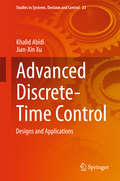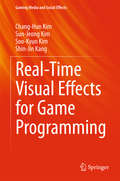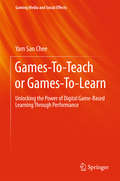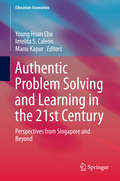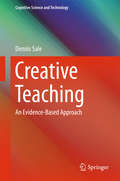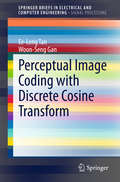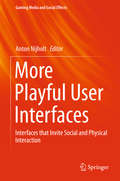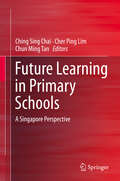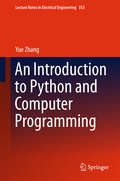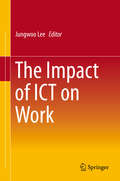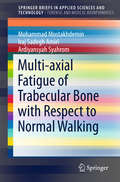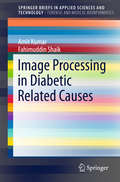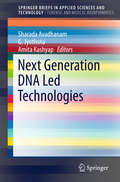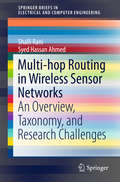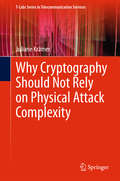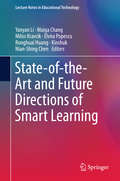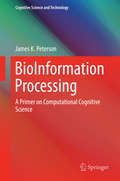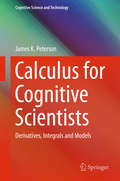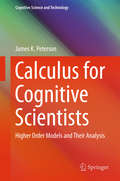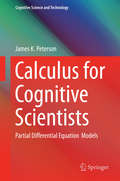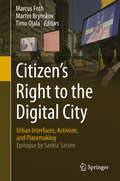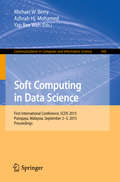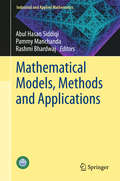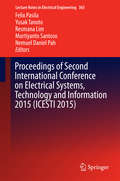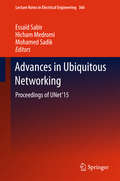- Table View
- List View
Advanced Discrete-Time Control: Designs and Applications (Studies in Systems, Decision and Control #23)
by Khalid Abidi Jian-Xin XuThis book covers a wide spectrum of systems such as linear and nonlinear multivariable systems as well as control problems such as disturbance, uncertainty and time-delays. The purpose of this book is to provide researchers and practitioners a manual for the design and application of advanced discrete-time controllers. The book presents six different control approaches depending on the type of system and control problem. The first and second approaches are based on Sliding Mode control (SMC) theory and are intended for linear systems with exogenous disturbances. The third and fourth approaches are based on adaptive control theory and are aimed at linear/nonlinear systems with periodically varying parametric uncertainty or systems with input delay. The fifth approach is based on Iterative learning control (ILC) theory and is aimed at uncertain linear/nonlinear systems with repeatable tasks and the final approach is based on fuzzy logic control (FLC) and is intended for highly uncertain systems with heuristic control knowledge. Detailed numerical examples are provided in each chapter to illustrate the design procedure for each control method. A number of practical control applications are also presented to show the problem solving process and effectiveness with the advanced discrete-time control approaches introduced in this book.
Real-Time Visual Effects for Game Programming (Gaming Media and Social Effects)
by Chang-Hun Kim Sun-Jeong Kim Soo-Kyun Kim Shin-Jin KangThis book introduces the latest visual effects (VFX) techniques that can be applied to game programming. The usefulness of the physicality-based VFX techniques, such as water, fire, smoke, and wind, has been proven through active involvement and utilization in movies and images. However, they have yet to be extensively applied in the game industry, due to the high technical barriers. Readers of this book can learn not only the theories about the latest VFX techniques, but also the methodology of game programming, step by step. The practical VFX processing techniques introduced in this book will provide very helpful information to game programmers. Due to the lack of instructional books about VFX-related game programming, the demand for knowledge regarding these high-tech VFXs might be very high.
Games-To-Teach or Games-To-Learn: Unlocking the Power of Digital Game-Based Learning Through Performance (Gaming Media and Social Effects)
by Yam San CheeThe book presents a critical evaluation of current approaches related to the use of digital games in education. The author identifies two competing paradigms: that of games-to-teach and games-to-learn. Arguing in favor of the latter, the author advances the case for approaching game-based learning through the theoretical lens of performance, rooted in play and dialog, to unlock the power of digital games for 21st century learning. Drawing upon the author’s research, three concrete exemplars of game-based learning curricula are described and discussed. The challenge of advancing game-based learning in education is addressed in the context of school reform. Finally, future prospects of and educational opportunities for game-based learning are articulated.Readers of the book will find the explication of performance theory applied to game-based learning especially interesting. This work constitutes the author’s original theorization. Readers will derive four main benefits: (1) an explication of the difference between game-based-teaching and game-based learning, and why this difference is of critical importance, (2) an exposition of the theory of game-based learning as performance, (3) concrete exemplars and research outcomes relating to three game-based learning curricula that have been empirically evaluated in schools, and (4) an understanding of complex issues related to the human side of school change that must be effectively addressed to achieve take-up of game-based learning in schools.
Authentic Problem Solving and Learning in the 21st Century: Perspectives from Singapore and Beyond (Education Innovation Series)
by Young Hoan Cho Imelda S. Caleon Manu KapurWith the rapid changes in the social, political, economic and technological landscape around the world, today’s learners face a more globally competitive job market after leaving school. The 21st century, which is characterized by the emergence of knowledge-based societies, expects learners to be comfortable in dealing with ambiguities and complexities in the real world and to be able to use knowledge as a tool at their workplace. This book will help readers develop an in-depth understanding of authentic problem solving and learning, and how it can be used to make a difference in their school or learning communities for the development of 21st century competencies. Comprising 20 chapters written by Singapore-based and international authors, the book is organized into three themes: authentic problems, authentic practices, and authentic participation. It details innovative school practices (e.g. productive failure) concerning the design of problems, learning activities, learning environments, and ICT tools for authentic problem solving and learning. Along with theoretical explanations of authentic learning processes and outcomes, the book also elucidates how students learn by generating and exploring solutions to complex problems and which cognitive functions are needed at different stages of problem-based learning. Presenting coherent descriptions of instructional design principles, successful cases and challenges encountered in K-12 schools and learning communities, the book provides useful information, new insights, and practical guidance for school directors, parents, teachers and researchers seeking to develop authentic learning environments for 21st century learners.
Creative Teaching: An Evidence-Based Approach (Cognitive Science and Technology)
by Dennis SaleThis book contains an evidence-based pedagogic guide to enable any motivated teaching/training professional to be able to teach effectively and creatively. It firstly summarises the extensive research field on human psychological functioning relating to learning and how this can be fully utilised in the design and facilitation of quality learning experiences. It then demonstrates what creativity actually 'looks like' in terms of teaching practices, modelling the underpinning processes of creative learning design and how to apply these in lesson planning. The book, having established an evidence-based and pedagogically driven approach to creative learning design, extensively focuses on key challenges facing teaching professionals today. These include utilising information technologies in blended learning formats, differentiating instruction, and developing self-directed learners who can think well. The main purpose of the book is to demystify what it means to teach creatively, explicitly demonstrating the principles of good pedagogic design and communication strategies that underpin such activity. The message is clear - creative teaching competence is both a highly useful and a learnable capability.
Perceptual Image Coding with Discrete Cosine Transform (SpringerBriefs in Electrical and Computer Engineering)
by Ee-Leng Tan Woon-Seng GanThis book first introduces classic as well as recent computational models for just-noticeable-difference (JND) applications. Since the discrete cosine transform (DCT) is applied in many image and video standards (JPEG, MPEG-1/2/4, H.261/3), the book also includes a comprehensive survey of computational models for JND that are based on DCT. The visual factors used in these computational models are reviewed in detail. Further, an extensive comparative analysis of these models using quantitative and qualitative performance criteria is presented, which compares the noise shaping performance of these models with subjective evaluation and the accuracy between the estimated JND thresholds and subjective evaluation.There are many surveys available on computational models for JND; however, these surveys seldom compare the performance of computational models that are based on DCT. The authors’ survey of the computational models and their in-depth review of the visual factors used in them will help readers understand perceptual image coding based on DCT. The book also provides a comparative analysis of several perceptual image coders that are based on DCT, which are compatible with the highly popular and widely adopted JPEG standard.
More Playful User Interfaces: Interfaces that Invite Social and Physical Interaction (Gaming Media and Social Effects)
by Anton NijholtThis book covers the latest advances in playful user interfaces – interfaces that invite social and physical interaction. These new developments include the use of audio, visual, tactile and physiological sensors to monitor, provide feedback and anticipate the behavior of human users. The decreasing cost of sensor and actuator technology makes it possible to integrate physical behavior information in human-computer interactions. This leads to many new entertainment and game applications that allow or require social and physical interaction in sensor- and actuator-equipped smart environments. The topics discussed include: human-nature interaction, human-animal interaction and the interaction with tangibles that are naturally integrated in our smart environments. Digitally supported remote audience participation in artistic or sport events is also discussed. One important theme that emerges throughout the book is the involvement of users in the digital-entertainment design process or even design and implementation of interactive entertainment by users themselves, including children doing so in educational settings.
Future Learning in Primary Schools: A Singapore Perspective
by Ching Sing Chai Cher Ping Lim Chun Ming TanThis edited book tells the story of the multifaceted efforts devoted by a “future school” in Singapore—The Nan Chiau Primary School—in shaping future learning. It documents the various measures implemented by one primary school to improve student learning outcomes in a technology-rich teaching and learning environment. With the current interest in Singapore’s “Masterplan for ICT (information and communication technology) in Education,” and the increasing focus on teaching and learning design by leading education researchers and professionals, this well-timed book will appeal to policy makers, educators and researchers.
An Introduction to Python and Computer Programming (Lecture Notes in Electrical Engineering #353)
by Yue ZhangThis book introduces Python programming language and fundamental concepts in algorithms and computing. Its target audience includes students and engineers with little or no background in programming, who need to master a practical programming language and learn the basic thinking in computer science/programming. The main contents come from lecture notes for engineering students from all disciplines, and has received high ratings. Its materials and ordering have been adjusted repeatedly according to classroom reception. Compared to alternative textbooks in the market, this book introduces the underlying Python implementation of number, string, list, tuple, dict, function, class, instance and module objects in a consistent and easy-to-understand way, making assignment, function definition, function call, mutability and binding environments understandable inside-out. By giving the abstraction of implementation mechanisms, this book builds a solid understanding of the Python programming language.
The Impact of ICT on Work
by Jungwoo LeeThis edited volume presents current perspectives on the innovative use of Information and Communication Technologies (ICT) as an integral part of the changing nature of work. The individual chapters address a number of key concepts such as telecommuting, alternative work arrangements, job crafting, gamification and new work skills, supplemented by a range of examples and supporting case studies. The Impact of ICT on Work offers a valuable resource for business practitioners and academics in the areas of information systems, as well as for human resources managers. The book will also be useful in advanced graduate classes dealing with the social and business impacts of information and communication technologies.
Multi-axial Fatigue of Trabecular Bone with Respect to Normal Walking (SpringerBriefs in Applied Sciences and Technology)
by Mohammad Mostakhdemin Iraj Sadegh Amiri Ardiyansyah SyahromThis book focuses on the analysis and treatment of osteoporotic bone based on drug administration, tracking fatigue behavior and taking into consideration the mechanical interaction of implants with trabecular bone. Weak trabeculae are one of the most important clinical features that need to be addressed in order to prevent hip joint fractures.
Image Processing in Diabetic Related Causes (SpringerBriefs in Applied Sciences and Technology)
by Amit Kumar Fahimuddin ShaikThis book is a collection of all the experimental results and analysis carried out on medical images of diabetic related causes. The experimental investigations have been carried out on images starting from very basic image processing techniques such as image enhancement to sophisticated image segmentation methods. This book is intended to create an awareness on diabetes and its related causes and image processing methods used to detect and forecast in a very simple way. This book is useful to researchers, Engineers, Medical Doctors and Bioinformatics researchers.
Next Generation DNA Led Technologies (SpringerBriefs in Applied Sciences and Technology)
by Sharada Avadhanam G. Jyothsna Amita KashyapThis brief highlights advances in DNA technologies and their wider applications. DNA is the source of life and has been studied since a generation, but very little is known as yet. Several sophisticated technologies of the current era have laid their foundations on the principle of DNA based mechanisms. DNA based technologies are bringing a new revolution of Advanced Science and Technology. Forensic Investigation, Medical Diagnosis, Paternity Disputes, Individual Identity, Health insurance, Motor Insurance have incorporated the DNA testing and profiling technologies for settling the issues.
Multi-hop Routing in Wireless Sensor Networks: An Overview, Taxonomy, and Research Challenges (SpringerBriefs in Electrical and Computer Engineering)
by Shalli Rani Syed Hassan AhmedThis brief provides an overview of recent developments in multi-hop routing protocols for Wireless Sensor Networks (WSNs). It introduces the various classifications of routing protocols and lists the pros and cons of each category, going beyond the conceptual overview of routing classifications offered in other books. Recently many researchers have proposed numerous multi-hop routing protocols and thereby created a need for a book that provides its readers with an up-to-date road map of this research paradigm.The authors present some of the most relevant results achieved by applying an algorithmic approach to the research on multi-hop routing protocols. The book covers measurements, experiences and lessons learned from the implementation of multi-hop communication prototypes. Furthermore, it describes future research challenges and as such serves as a useful guide for students and researchers alike.
Why Cryptography Should Not Rely on Physical Attack Complexity (T-Labs Series in Telecommunication Services)
by Juliane KrämerThis book presents two practical physical attacks. It shows how attackers can reveal the secret key of symmetric as well as asymmetric cryptographic algorithms based on these attacks, and presents countermeasures on the software and the hardware level that can help to prevent them in the future. Though their theory has been known for several years now, since neither attack has yet been successfully implemented in practice, they have generally not been considered a serious threat. In short, their physical attack complexity has been overestimated and the implied security threat has been underestimated. First, the book introduces the photonic side channel, which offers not only temporal resolution, but also the highest possible spatial resolution. Due to the high cost of its initial implementation, it has not been taken seriously. The work shows both simple and differential photonic side channel analyses. Then, it presents a fault attack against pairing-based cryptography. Due to the need for at least two independent precise faults in a single pairing computation, it has not been taken seriously either.Based on these two attacks, the book demonstrates that the assessment of physical attack complexity is error-prone, and as such cryptography should not rely on it. Cryptographic technologies have to be protected against all physical attacks, whether they have already been successfully implemented or not. The development of countermeasures does not require the successful execution of an attack but can already be carried out as soon as the principle of a side channel or a fault attack is sufficiently understood.
State-of-the-Art and Future Directions of Smart Learning (Lecture Notes in Educational Technology #0)
by Yanyan Li Maiga Chang Milos Kravcik Elvira Popescu Ronghuai Huang Kinshuk Nian-Shing ChenThis book provides an archival forum for researchers, academics, practitioners and industry professionals interested and/or engaged in reforming teaching and learning methods by transforming today’s learning environments into smart learning environments. It will facilitate opportunities for discussions and constructive dialogue between various stakeholders on the limitations of current learning environments, the need for reform, innovative uses of emerging pedagogical approaches and technologies, and sharing and promoting best practices, which will lead to the evolution, design and implementation of smart learning environments. The focus of the contributions is on the interplay and fusion of pedagogy and technology to create these new environments. The components of this interplay include but are not limited to:Pedagogy: learning paradigms, assessment paradigms, social factors, policy Technology: emerging technologies, innovative uses of mature technologies, adoption, usability, standards, and emerging/new technological paradigms (open educational resources, cloud computing, etc.)Fusion of pedagogy and technology: transformation of curricula, transformation of teaching behavior, transformation of administration, best practices of infusion, piloting of new ideas.
BioInformation Processing: A Primer on Computational Cognitive Science (Cognitive Science and Technology)
by James K. PetersonThis book shows how mathematics, computer science and science can be usefully and seamlessly intertwined. It begins with a general model of cognitive processes in a network of computational nodes, such as neurons, using a variety of tools from mathematics, computational science and neurobiology. It then moves on to solve the diffusion model from a low-level random walk point of view. It also demonstrates how this idea can be used in a new approach to solving the cable equation, in order to better understand the neural computation approximations. It introduces specialized data for emotional content, which allows a brain model to be built using MatLab tools, and also highlights a simple model of cognitive dysfunction.
Calculus for Cognitive Scientists: Derivatives, Integrals and Models (Cognitive Science and Technology #0)
by James K. PetersonThis book provides a self-study program on how mathematics, computer science and science can be usefully and seamlessly intertwined. Learning to use ideas from mathematics and computation is essential for understanding approaches to cognitive and biological science. As such the book covers calculus on one variable and two variables and works through a number of interesting first-order ODE models. It clearly uses MatLab in computational exercises where the models cannot be solved by hand, and also helps readers to understand that approximations cause errors – a fact that must always be kept in mind.
Calculus for Cognitive Scientists: Higher Order Models and Their Analysis (Cognitive Science and Technology #0)
by James K. PetersonThis book offers a self-study program on how mathematics, computer science and science can be profitably and seamlessly intertwined. This book focuses on two variable ODE models, both linear and nonlinear, and highlights theoretical and computational tools using MATLAB to explain their solutions. It also shows how to solve cable models using separation of variables and the Fourier Series.
Calculus for Cognitive Scientists: Partial Differential Equation Models (Cognitive Science and Technology #0)
by James PetersonThis book shows cognitive scientists in training how mathematics, computer science and science can be usefully and seamlessly intertwined. It is a follow-up to the first two volumes on mathematics for cognitive scientists, and includes the mathematics and computational tools needed to understand how to compute the terms in the Fourier series expansions that solve the cable equation. The latter is derived from first principles by going back to cellular biology and the relevant biophysics. A detailed discussion of ion movement through cellular membranes, and an explanation of how the equations that govern such ion movement leading to the standard transient cable equation are included. There are also solutions for the cable model using separation of variables, as well an explanation of why Fourier series converge and a description of the implementation of MatLab tools to compute the solutions. Finally, the standard Hodgkin - Huxley model is developed for an excitable neuron and is solved using MatLab.
Citizen’s Right to the Digital City: Urban Interfaces, Activism, and Placemaking
by Marcus Foth Martin Brynskov Timo OjalaEdited by thought leaders in the fields of urban informatics and urban interaction design, this book brings together case studies and examples from around the world to discuss the role that urban interfaces, citizen action, and city making play in the quest to create and maintain not only secure and resilient, but productive, sustainable and viable urban environments. The book debates the impact of these trends on theory, policy and practice. The individual chapters are based on blind peer reviewed contributions by leading researchers working at the intersection of the social / cultural, technical / digital, and physical / spatial domains of urbanism scholarship. The book will appeal not only to researchers and students, but also to a vast number of practitioners in the private and public sector interested in accessible content that clearly and rigorously analyses the potential offered by urban interfaces, mobile technology, and location-based services in the context of engaging people with open, smart and participatory urban environments.
Soft Computing in Data Science: First International Conference, SCDS 2015, Putrajaya, Malaysia, September 2-3, 2015, Proceedings (Communications in Computer and Information Science #545)
by Michael W. Berry Azlinah Mohamed Bee Wah YapThis book constitutes the refereed proceedings of the International Conference on Soft Computing in Data Science, SCDS 2015, held in Putrajaya, Malaysia, in September 2015.The 25 revised full papers presented were carefully reviewed and selected from 69 submissions. The papers are organized in topical sections on data mining; fuzzy computing; evolutionary computing and optimization; pattern recognition; human machine interface; hybrid methods.
Mathematical Models, Methods and Applications (Industrial and Applied Mathematics)
by Abul Hasan Siddiqi Pammy Manchanda Rashmi BhardwajThe present volume contains invited talks of 11th biennial conference on “Emerging Mathematical Methods, Models and Algorithms for Science and Technology”. The main message of the book is that mathematics has a great potential to analyse and understand the challenging problems of nanotechnology, biotechnology, medical science, oil industry and financial technology. The book highlights all the features and main theme discussed in the conference. All contributing authors are eminent academicians, scientists, researchers and scholars in their respective fields, hailing from around the world.
Proceedings of Second International Conference on Electrical Systems, Technology and Information 2015 (Lecture Notes in Electrical Engineering #365)
by Felix Pasila Yusak Tanoto Resmana Lim Murtiyanto Santoso Nemuel Daniel PahThis book includes the original, peer-reviewed research papers from the 2nd International Conference on Electrical Systems, Technology and Information (ICESTI 2015), held in September 2015 at Patra Jasa Resort & Villas Bali, Indonesia. Topics covered include: Mechatronics and Robotics, Circuits and Systems, Power and Energy Systems, Control and Industrial Automation, and Information Theory. It explores emerging technologies and their application in a broad range of engineering disciplines, including communication technologies and smart grids. It examines hybrid intelligent and knowledge-based control, embedded systems, and machine learning. It also presents emerging research and recent application in green energy system and storage.It discusses the role of electrical engineering in biomedical, industrial and mechanical systems, as well as multimedia systems and applications, computer vision and image and signal processing. The primary objective of this series is to provide references for dissemination and discussion of the above topics. This volume is unique in that it includes work related to hybrid intelligent control and its applications. Engineers and researchers as well as teachers from academia and professionals in industry and government will gain valuable insights into interdisciplinary solutions in the field of emerging electrical technologies and its applications.
Advances in Ubiquitous Networking: Proceedings of the UNet’15 (Lecture Notes in Electrical Engineering #366)
by Essaïd Sabir Hicham Medromi Mohamed SadikThis volume publishes new trends and findings in hot topics related to ubiquitous computing/networking. It is the outcome of UNet - ainternational scientific event that took place on September 08-10, 2015, in the fascinating city of Casablanca, Morocco. UNet’15 is technically sponsored by IEEE Morocco Section and IEEE COMSOC Morocco Chapter.
